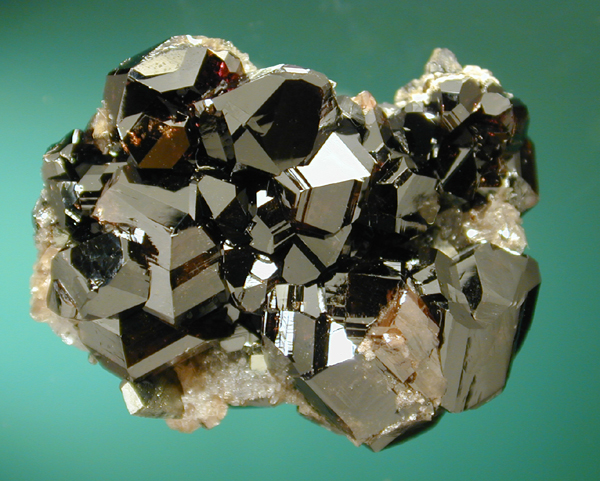| Crystal system | Tetragonal |
| Transparency | Transparent to translucent in gem quality |
| Luster | adamantine to subadamantine |
| Fracture | Conchoidal to uneven |
| Cleavage | Good basal |
| Specific Gravity | 6.95 |
| Hardness | 6-7 |
| Optical Character | Uniaxial + ; Double Refractive |
| Refractive index | 1.997-2.093 |
| Birefringence | 0.096 |
| Dispersion | 0.071 |
| Fluorescence | None |
| Pleochroism | |
| Chemical Formula | SnO2 |
| Comments | |
| Streak | White to pale brown or yellow |
The mineral cassiterite (cah-SIT-er-ite) is much more important as the principal ore of tin than it is as a gemstone; in fact, the name comes through the Latin from the Greek word meaning "tin". In its rare transparent form, however, it has sufficient brilliancy and dispersion to be a very attractive stone. Usually, the color is decidedly dark brown, but yellow and even colorless material is encountered occasionally.
Cassiterite is one of those minerals that is thought to have formed by the action of gasses; i.e., to have crystallized directly from a gas. Volatile material from a magmatic intrusion rising through crevices above the molten area crystallized in veins to form cassiterite. Associated minerals are topaz, fluorite, tourmaline, quartz and apatite. It is also found frequently as a constituent of alluvial deposits.
Important localities include Bolivia; Malaysia; Cornwall, England; Saxony; Australia; and Mexico.
Cassiterite, which is tin oxide (SnO2), crystallizes in the tetragonal system. The crystals are usually prismatic with pointed pyramidal ends; twin crystals sometimes occur. Its hardness ranges from 6 to 7 and it is one of the tougher gem minerals. The cleavage is highly imperfect and the fracture is conchoidal to uneven. One of its most interesting properties is its high specific gravity: about 6.87 to 7.03 in gem quality. The streak is white to pale brown or yellow and there are no diagnostic inclusions. The luster is adamantine to subadamantine. With refractive indices of 1.997 - 2.093 the resultant birefringence of .096 produces strong doubling of back facet junctions. The dispersion of .071 is considerably greater than that of diamond. The optic character is uniaxial positive. No phenomenon is exhibited. In the flame of the blowpipe or jeweler's torch cassiterite is infusible; it is only slightly affected by acids.
Cassiterite would be difficult to distinguish from the rare mineral sphene in a mounting except by obtaining an interference figure. A loose stone, however, could be detected readily by its enormous specific gravity, usually merely by "hefting" it in the hand.
Transparent material is fashioned in either the brilliant or step-cut style, and semitransparent to translucent stones are cut in the cabochon form. Cassiterite saws with difficulty and tends to glaze the diamond saw blade. Cabochon material is wet sanded on very fine sanding cloth and polished on a leather lap with Linde A powder. Faceted material polishes best with Linde A on a tin lap that is allowed to run almost dry. Crown angles of 35° and pavilion angles of 41° are recommended.
The demand for this mineral is limited principally to collectors.
A fine specimen is so rare that it commands a fairly high price. The
GIA collection includes a dark-brown brilliant cut stone of about
five carats in weight.


